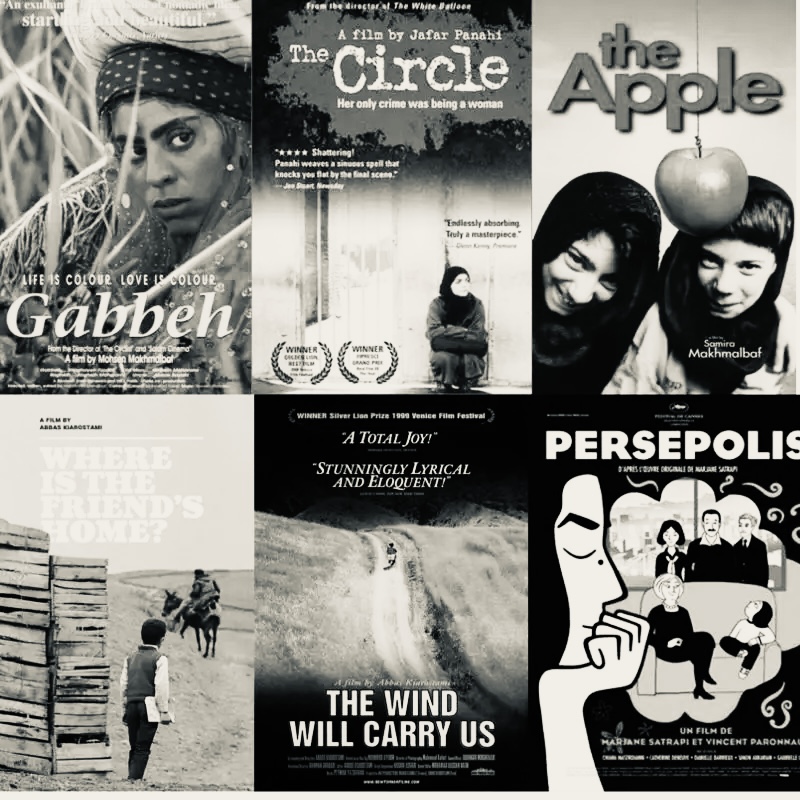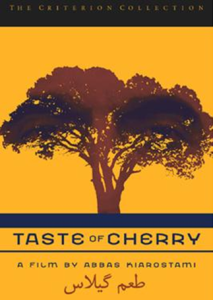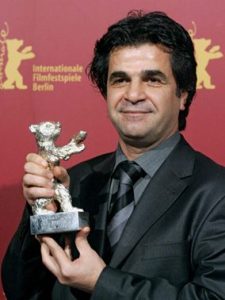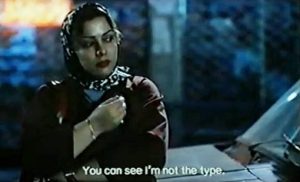
On the Western Reception of Iranian Cinema

Figure 1: A still from the film Gabbah, directed by Muhsin Makhmalbāf, 1996.
Introduction: Cinema as Tourism
“I think gabbehs are like good Iranian films,” Muhsin Makhmalbāf noted while promoting one of his more popular films, Gabbah, in 2012:
What attracts foreign audiences to Iranian films is their simplicity and their recreation of nature. These are the same two qualities that have also made gabbehs popular in foreign markets. In Western countries people are overwhelmed by difficult, complicated, and rough situations. When they go to the movies they don’t want to see the same complexity and violence they are surrounded by. That is why they are fascinated by simple Iranian films that remind them of nature. Iranian gabbehs also have a sort of naturalistic poetry about them that gives you a sense of tranquility. You feel that you have spread nature on the floor of your living room.1Jonathan Rosenbaum, “Packaged Parables,” JonathanRosenbaum.net, February 2024, https://jonathanrosenbaum.net/2024/02/packaged-parables/.
A gabbah is a kind of Iranian carpet produced by the nomadic Qashqā’ī tribe and compared by some to American quilts as a similar form of folk art. Makhmalbāf estimates that only one out of every ten thousand Iranians owns a gabbah and that only one out of every thousand has even heard of one—facts that suggest Makhmalbāf himself is a bit of a tourist when describing gabbahs. Even if one questions whether the best Iranian films are simple recreations of nature, the notion that Iranian filmmakers and films and their foreign audiences are all parts of the tourist trade seems harder to shake off. As a luxury item that can appeal to the imagination, stimulate an aura of fairy tales, and summon up an idea of preindustrial Iran that can fit cozily inside any Westerner’s home, the gabbah is a consumer object, a Disney-like cartoon feature, and a visionary art-movie icon all rolled into one.

Figure 2: A still from Gabbah, directed by Muhsin Makhmalbāf, 1996, showing a Gabbah — a traditional handwoven Iranian rug.
All this suggests that the relation of non-Iranian audiences to Iranian cinema is essentially a form of tourism. This helps to explain why Gabbah had a bigger impact on Western audiences than Makhmalbāf’s earlier Marriage of the Blessed (ʿArūsī-i Khūbān, 1989), a film that has far more to say and to convey about Iranian life and culture.
This also may help to explain part of the basis for Rex Reed’s extravagant, four-star review of Ben Affleck’s Argo in the October 9, 2012, issue of the New York Observer, calling it “a movie that defines perfection”:
Gifted, intelligent and full of cogent ideas, Mr. Affleck can almost always be depended on to come up with something fascinating, coherent and thoroughly cinematic. Argo […] is no exception. It grabbed me by the lapels and held my attention for two solid hours without a sideward glance, and I can’t wait to see it again. You have to see it twice if you want to absorb the myriad pieces of a jigsaw too fantastic to accept as fact, although we know going in that the recently declassified records of an amazing history lesson prove otherwise. This movie is not only true, but unbelievably true.2Rex Reed, “Ben Affleck’s Argo Is a Masterpiece,” Observer, October 12, 2012, https://observer.com/2012/10/rex-reed-argo-ben-affleck/.

Figure 3: Poster of the film Argo, directed by Ben Affleck, 2012.
A desire not for the truth but for “the unbelievable truth” is ultimately a desire for “perfection,” not information. Thus the CIA’s rescue of six Americans from Tehran during the Iran hostage crisis of 1979 is a subject that can be “understood” only from the vantage point of American entertainment. Many Iranian-American commentators complained about the historical distortions and bogus facts about Iran used by Ben Affleck and his writer Chris Terrero, only two of which I will point out here: the suggestion that the Shah’s wife bathed in milk while the Shah had his lunches flown in by Concorde from Paris. Admittedly, both of these absurd claims are cited only as rumors just after the 1953 coup d’état by the U.S. and Britain that deposed the democratically elected Muhammad Musaddiq—which, to the credit of Argo, is cited as fact, not as rumor. But the milk bathing nevertheless warrants and receives a full illustration, in both black and white and color, during a comic-strip history of Iran that opens the film, because this yields a far more memorable (i.e. “perfect”) image than the aforementioned coup d’état. To put it simply, tourists want spectacle more than deeper understanding, so the milk bath has a better sales value than the overthrow of a government that helped to motivate the 1979 hostage crisis.
A far more notable as well as verifiable activity of the Shah’s wife was the founding in the 1960s of Kānūn—the Center for the Intellectual Development of Children and Young Adults—that occasioned and even necessitated the introduction of ‛Abbās Kiyārustamī to filmmaking when he was asked to help lead Kānūn’s film unit. This fact is more notable and verifiable, but also far less functional, even useless, if one wants to recount a comic-strip history and employ thriller mechanics, which is what Affleck needs for his story.
I
Here are three quotations from American film critics roughly a quarter of a century ago, all expressing skepticism about Kiyārustamī’s Taste of Cherry (Taʿm-i Gīlās, 1997) and/or American defenses of Kiyārustamī:
1. Roger Ebert
There was great drama at Cannes last year when the Iranian director Abbas Kiarostami was allowed, at the last moment, to leave his country and attend the festival premiere of his new film, Taste of Cherry. He received a standing ovation as he entered the theater, and another at the end of his film (although this time mixed with boos), and the jury eventually made the film co-winner of the Palme d’Or.
Back at the Hotel Splendid, standing in the lobby, I found myself in lively disagreement with two critics I respect, Jonathan Rosenbaum of the Chicago Reader and Dave Kehr of the New York Daily News. Both believed they had seen a masterpiece. I thought I had seen an emperor without any clothes.
A case can be made for the movie, but it would involve transforming the experience of viewing the film (which is excruciatingly boring) into something more interesting, a fable about life and death. Just as a bad novel can be made into a good movie, so can a boring movie be made into a fascinating movie review.3Roger Ebert, “Reviews: Taste of Cherry,” Chicago Sun-Times, February 27, 1998, https://www.rogerebert.com/reviews/taste-of-cherry-1998.
2. David Denby
The quiet bravura of Abbas Kiarostami’s Taste of Cherry has received the highest praise, both here and abroad. At Cannes, in 1997, the movie shared the Palme d’Or […], and a number of American critics have hailed it as a masterpiece. A masterpiece! I agree that Taste of Cherry is an interesting and unusual movie, but still, I wonder—that is, I struggle like an infidel against evil thoughts. First, an acknowledgment: Kiarostami, the most celebrated director of the Iranian cinema, is a man both delicate in his perceptions and generous in his sentiments; he also wields enormous formal control over his material. Yet I can’t help thinking that the comparisons to De Sica and Satyajit Ray and other masters betray a degree of critical desperation. Is this movie rich enough—does it show the many-sided vitality of the great movies of the past – to warrant the extravagant praise? Or are critics, depressed by the obvious aesthetic poverty of world cinema, arguing themselves into it, placing their bets on Kiarostami because they have no other cards to play? That could be a risky game. When an audience is primed to encounter a royal personage in breastplate and plumes, it can turn vindictive when it discovers instead an emperor wearing no clothes.4David Denby, “Nowhere Man,” New York Magazine, April 6, 1998, https://nymag.com/nymetro/movies/reviews/2509/.

Figure 4: ‛Abbās Kiyārustamī with Catherine Deneuve and Kōji Yakusho at the 1997 Cannes Film Festival.
3. Howard Hampton:
In its regard for ordinary people and the ways it finds to honor the mysteries of everyday life—along with the film’s diffuse sense of time and its synthesis of almost pure visual abstraction and unadorned emotional intimacy— [David Lynch’s] The Straight Story has obvious affinities with Iranian cinema’s meld of realism and fable. But although the film was by and large enthusiastically if not perceptively received by mainstream reviewers, the serious critics who have championed like-minded foreign films were less generous, even condescending or outright dismissive… Even a largely sympathetic reviewer like the Chicago Reader’s Jonathan Rosenbaum called the movie “propaganda,” as if Lynch’s taking money from Disney were inherently more compromising than Abbas Kiarostami’s working under the aegis of a totalitarian theocracy.
[…] The Straight Story’s headstrong old gentleman and the relentlessly single-minded protagonists of Kiarostami’s films, or the equally determined little girl of Jafar Panahi’s 1995, Kiarostami-scripted White Balloon (not to mention the upright, fiercely independent senior citizen Umberto D. of an earlier, no less allegorical branch of Neorealism), have an innate kinship—they are gnarled branches of the same cinematic family tree. Yet there is a widespread view among the film intelligentsia that humanity is the specialized province of the salt of the foreign earth, where indigenous cultures are typically mediated through familiar Eurocentric tropes and gestures (depoliticized avant-Godardisms, Bresson-oil rubdowns, the many moods of Antonioni). For these rigidly positioned film missionaries, places like Iowa are what they fly over on their pilgrimages to Lourdes-like film festivals—where true believers seek healing epiphanies, artistic ‘miracles,’ the blessings of directorial saints.5Howard Hampton, “Lynch Mob,” Artforum, January 2000, https://www.thefreelibrary.com/LYNCH+MOB.-a059460574.

Figure 5: Poster of the film Taste of Cherry (Taʿm-i Gīlās), directed by ‛Abbās Kiyārustamī, 1997.
Two particular issues are raised by these quotations regarding either puzzlement about what Kiyārustamī is doing (Roger Ebert and David Denby) or what is arguably unjustified and misplaced confidence about understanding what Kiyārustamī is doing (Howard Hampton).
Ebert appears to be more honest about his puzzlement than Denby, who can’t resist inserting a sarcastic wisecrack about Islamic beliefs (“I struggle like an infidel against evil thoughts”) without explaining how or why he considers such beliefs relevant aside from the fact that Kiyārustamī is Iranian. In short, if a capacity to distinguish between “Islamic” and “Iranian” is one of the key prerequisites for understanding Iranian culture, Denby seems unwilling to make such a distinction. He also avoids distinguishing between the films he has seen, the films he has access to, and all the other films that exist in the world. The “obvious aesthetic poverty of the world cinema” can thus become “obvious” only if one has seen everything comprising “world cinema,” and because obviously no one has or can, Denby doesn’t seem to consider it important to distinguish between everything he has seen and everything he has not in arriving at such a massive, global judgment. One might even conclude that dismissing most of the world as impoverished and therefore as irrelevant is something that many United States citizens already do as a matter of routine habit, according to which the poverty of world cinema, aesthetic and otherwise, becomes both obvious and inescapable.
I’ve often believed that one of the key drawbacks to living in any of the truly expansive countries such as China, India, Russia, and the U.S. is that you are surrounded by people who regard their own country as the world and therefore all that counts or matters, meaning in effect that they (and you) are more than a little bit inattentive towards other countries. It is a paradox that what is regarded as worldly nowadays is really just a repackaging of some version of provinciality and familiarity. And it hardly seems exaggerated to claim that blindness or indifference to other cultures is part of the way that Americans respond to Iranian films, made worse by the lack of knowledge about the influence of Iranian censorship on what can or can’t be shown. For example, it probably isn’t clear to most Western viewers that the reason why so much of contemporary Iranian art cinema occurs outdoors is that showing women in their homes without their hijabs is forbidden. Furthermore, the prohibitions in earlier phases of Iranian film history (I’m told that at one stage, close-ups of women were not allowed), combined with the fact that Iranian film censors are not obliged to give reasons for their cuts, likely foster more confusion, in some cases for Iranian filmgoers as well as for their Western counterparts. Indeed, the domestic and international gossip that has circulated about Kiyārustamī’s Taste of Cherry ever since it shared the Palme d’Or at the Cannes film festival—including diverse speculations about the degree to which the theme of suicide affected the film’s visibility inside Iran—has made it virtually impossible for Westerners such as myself to arrive at a coherent account of what happened.

Figure 6: Scenes from Taste of Cherry (Taʿm-i Gīlās), directed by ‛Abbās Kiyārustamī, 1997.
The relative provinciality of the largest countries seems worth emphasizing because of the way “Americans” (that is, U.S. citizens whose status as North Americans is thus abbreviated, a privilege generally denied to Mexicans and Canadians) view the world clearly affects the way they view world cinema. The seeming presumption of Hampton that ‛Abbās Kiyārustamī and David Lynch are like-minded colleagues making separate versions of the same sort of movie seems directly tied to the common “American” assumption that the world is divided between Americans, people who want to be Americans, and people who hate Americans, so that indifference to “America” and “Americans” isn’t even regarded as an option.
In an angry letter I sent to Artforum responding to Hampton’s essay, which appeared in their next issue, I rhetorically asked Hampton where he saw “propaganda for theocracy or totalitarianism in Kiarostami’s work” and what he meant by “working under the aegis of,” especially when Lynch was obliged to test-market his film and Kiyārustamī wasn’t.6For a much fuller account of this exchange see, Mehrnaz Saeed-Vafa & Jonathan Rosenbaum, Abbas Kiarostami (Urbana/Chicago: University of Illinois Press, 2003), 90-92, 94-97. Yet the fact that so much of what happens in and in relation to Iranian cinema is conveyed to the public both inside and outside Iran as gossip can only foster many ongoing forms of misinformation and distortion. Based on my own limited experience and perspective, I would hypothesize that a similar condition of shared befuddlement characterizes the public’s understanding of the motives of Russian film censorship, especially in its pre-glasnost manifestations.
Western responses to Iranian cinema encompass much more, of course, than responses to Kiyārustamī. I have nevertheless started with these examples because they dramatize the extent to which much broader issues, such as the ideological biases and limitations of larger countries considering smaller countries, reflect and even determine how the West responds to Iranian cinema. One has to factor in the almost complete unfamiliarity of Western viewers with Iranian history, including the role played by the CIA in fostering the 1953 coup that ended Iranian democracy, and a tendency to demonize Iranian culture based on the dimly understood 1979 hostage crisis. This makes Ebert’s and Denby’s charge that “the emperor has no clothes” a fairy tale concept, like so many of the images associated with the Arabian Nights, suggesting both comic book fantasies of Persia and an unwitting acknowledgment of the literal void that often characterizes Western understandings of Iran.
Indeed, the limitations of the Western reception of Iranian cinema are inscribed in many such cultural conditions that tend to be unexamined. Some of these cultural conditions include (and this is very far from an exhaustive list, the issue here being not their veracity or falseness but the full range of positions that they suggest):
- Limitations of how large Western countries perceive (and don’t perceive) other countries.
- The Western film industry’s conceptions of commercial cinema and art cinema. and what both “foreign” cinema in general and Iranian cinema in particular consist of.
- A widespread belief that films can be unproblematically labeled “good” or “bad” universally.
- The idea that banned films are more likely to be “good” than unbanned films.
- “Good” films should be seen, and “bad” films should be avoided (overlooking the possibility that there might be good, i.e. informative or educational reasons to see “bad” films that aren’t tied to consumption models).
- A belief that “Third World” filmmakers from totalitarian regimes have a moral obligation to criticize their own regimes, unlike many or most “First World” filmmakers.
- A widespread belief that Iranian filmmakers whose films aren’t critical of Iran implicitly support and endorse its totalitarian regime.
- Iranian films need to be entertaining before they can be enlightening.
- Iranian films need to be enlightening before they can be entertaining.
- Iranian films were ignored by Western critics until recently because they weren’t “good” enough.
- Iranian films were ignored by Western critics until recently because the critics weren’t more sophisticated.
- Iranian films were ignored by Western critics until recently because they weren’t exported or made available in the West.
- It is possible to determine whether any given year is a “good” year or a “bad” year for cinema.
- Even though it is not possible for any individual viewer or critic to determine whether any given year is a “good” year or a “bad” year for cinema, it’s still reasonable and useful for any viewer or critic to create and publish a “ten best list.”
- Characterizing any film as “political” is both hazardous and often confusing, especially if one is uncertain about what distinguishes political commentary from social commentary. For example, Stanley Kauffmann’s 1995 review of Kiyārustamī’s Through the Olive Trees (Zīr-i Dirakhtān-i Zaytūn, 1994) asks the question, “Do we still need reminders that human connections, conveyed in art, persist through political differences?”7Stanley Kauffmann, Regarding Film (Baltimore/ London: The Johns Hopkins University Press, 2001), 67-68. I suspect that Kauffmann’s assumption of political differences between himself and Kiyārustamī stems not from his knowledge of Iranian culture but from insecurity and uncertainty about his lack of knowledge, and I would submit that such confusions underlie many, perhaps most Western reviews of Iranian films.
- The best Iranian films are those that appeal to the most people, Iranian and non-Iranian.
- The best Iranian films are those that are banned in Iran.
- Because Iranian cinema is the most humanist of all nationalist cinemas, the best Iranian films are the most humanist (e.g., Furūgh Farrukhzād’s The House is Black [Khānah Siyāh Ast]).
I have deliberately made the above list as contradictory as possible because the dealings of the West with Iran and the critical positions of virtually everyone regarding cinema have shown a comparable illogic and lack of continuity. I’ve tried to suggest the confused and confusing spectrum of Western attitudes about Iranian cinema in this list. They all reflect an overall condition of “unfinished business” when it comes to these matters, which tend to be taken up only to be subsequently contradicted or abandoned due to subsequent events or pressures. It is worth adding that almost all of these events and pressures are dictated by the whims of capitalism—that is, some version of the marketplace and its fluctuations. Thus, the reluctance of capitalist institutions both inside and outside Iran to discuss or even acknowledge various forms of capitalist censorship (such as censoring films or elements in films that are deemed noncommercial) has tended to make Iranian censorship seem more singular and exceptional than it actually is.
I have chosen to highlight these concerns because film criticism everywhere tends to be riddled with confusions and contradictions of this kind, twisted into temporary shapes by the marketplace and its clarifying or obfuscating ideologies before being replaced by others that are often equally questionable. Even the basic and seemingly universal belief that films can be regarded as “good” or “bad” overlooks the question of what makes something “good” or “bad” for what, and for whom. The seeming conviction that a film, an idea, a person, or a country can be “good” or “bad” strikes me as ridiculous, yet entire industries such as the Academy Awards have been created to honor and promulgate such convictions. Even the degree to which the Academy Awards are a method of both advertising and the resale of products that have already been sold tends to be minimized in public discussions.

Figure 7: Portrait of Ja‛far Panāhī holding the Silver Bear award at the 2015 Berlin International Film Festival.
II
One of the most striking things about Western attitudes toward Ja‛far Panāhī, at least in recent years, is that they appear to equate his talent as a filmmaker with his defiance against the government rather than with any aesthetic distinction. Paradoxically, Panāhī’s rebellion in continuing to make films after being forbidden to do so appears to be considered more important and newsworthy than the social critiques of his pre-arrest features—the specific treatments of class difference in The White Balloon (Bādkunak-i Sifīd, 1995) and Crimson Gold (Talā-yi Surkh, 2003) and misogyny in The Circle (Dāyirah, 2000) and Offside (Āfsāyd, 2006)—even though one could easily find these latter achievements to be far more important in terms of both their activism and their art. The earlier films address how members of the working class and women are treated, clearly huge topics, whereas thanks to Panāhī’s unusual position as a banned filmmaker, This is Not a Film (Īn Fīlm Nīst, 2011), Closed Curtain (Pardah, 2013), Taxi (Tāksī, 2015), and No Bears (Khirs Nīst, 2022) can address only how he is treated, a much narrower subject. I should point out, however, that the class difference between the two main child characters in The White Balloon apparently wasn’t noticed or deemed significant by most Western reviewers, and that an overall avoidance of class issues tends to be a universal trait.
I hasten to add that The White Balloon was one of the first Iranian films to win a major award at Cannes (the Caméra d’Or), preceded only by Kiyārustamī’s …And Life Goes On (Zindagī va Dīgar Hīch, 1992). The Circle, Crimson Gold, and Offside won awards at other major film festivals. Yet perhaps because it is easier to focus on individuals than on films, and on causes rather than on works of art, it wasn’t until Panāhī was arrested in 2010, sentenced to six years in prison, and banned from all filmmaking activities for the next 20 years, that he was noticed at all in the mainstream press in the West.
One important factor that helps to explain this anomaly is the fact that all eight of the Panāhī features cited above qualify as “festival films,” existing within the specific bubbles of “media events” designed to attract the international press as potential mainstream news items. An overall ambiguity about what separates film criticism from advertising and reviewing from journalistic reporting—which I would maintain is even more prevalent at Cannes than at other festivals, precisely because it is monitored as well as encouraged by publicists and because Cannes is deemed the most important venue for commercially launching foreign films—inevitably shortens most valuable criticism of films into snappy slogans.
Both Panāhī and Muhammad Rasūluf have insisted that their films qualify as social critiques rather than as political critiques, but even the status of their films as social critiques can be matters of dispute and controversy. This is especially the case with The Circle, a film I regard as Panāhī’s most radical work aesthetically as well as socio-politically, but which two Iranian writers outside Iran, both women studies professors, Roksana Bahramitash and Homa Hoodfar, regard as corrupt and reprehensible.

Figure 8: Poster of the film The Circle (Dāyirah), directed by Ja‛far Panāhī, 2000.
After Panāhī rejected a proposal to show The Circle at the Fajr film festival with the final 18 minutes removed, but ended up showing a video of the uncut version in his house to foreign guests, he was accused by Bahramitash and Hoodfar in the Montreal Gazette of tailoring his film for the West and reinforcing Western stereotypes about Iranians. They outlined:
[…] three distinct kinds of problems for those of us intent on familiarizing people with the realities of women’s situation in the Muslim world. First, [The Circle] ignores completely the multiplicity of women’s acts of resistance to and subversion of oppressive practices. Second, it presents the story of Iranian women as one of continuous defeat. As a result, they seem in dire need of a white knight to ride in from the West, much as the Crusaders did, to rescue them. Third, it compromises Muslim women’s position and poisons the atmosphere among family, friends and community. When one of our teenage daughters saw the movie, she whispered: “I will never go back to Iran because of her shame about being Iranian.”8Roksana Bahramitash and Homa Hoodfar, “Faces of Iranian Feminism,” Montreal Serai 14, no. 2 (2001), https://montrealserai.com/_archives/2001_Volume_14/14_2/Article_6.htm.
There is always a price to pay for expressing negative perceptions of reality. But to suggest that the women shown in The Circle are all “defeated” seems to me a reductive and misleading summary of a story where solidarity between women, shown in varying degrees, obviously counts for something, along with highly visible signs of female pride, anger, and defiance. One of the first things we see in the film, for example, is a woman aggressively berating a passing male on the street for asking her and a friend, “You two alone?”—not exactly the behavior of a passive victim. And when these academics add that “the movie was made by a man, evidently seeking Hollywood success,” they offer a good illustration of how what seems “good” and progressive to some (myself included) might seem “bad,” regressive, and even corrupt to others.
To be honest, I should admit that even though I have never considered myself a white knight rescuing damsels in distress, my lengthy defense of The Circle that was published in the Chicago Reader on June 8, 2001 is based in part on an extended comparison with film noir, a Hollywood genre (albeit one that wasn’t formulated or even named until many years later):
This is the first Iranian noir I’ve seen—and I’m using “noir” here to denote a style that isn’t “ours” but the world’s. After all, the term itself is French, and it’s worth adding that France has probably influenced Iran as much as us. (The most common way of saying “thank you” in Tehran, audible in The Circle, is “merci”.) Fear and noir typically go together—and the most frightening of Val Lewton’s noirish B films, The Leopard Man, has a somewhat similar narrative structure, a narrative relay passing from one character to the next ⸺though so do Luis Buñuel’s The Phantom of Liberty and Richard Linklater’s Slacker, among other arthouse examples.
Mainstream movie counterparts come as readily to mind. In more ways than I can count, The Circle is also like a punchy Warners proletarian-protest quickie of the 30s, with salty convicts, a hard-nosed, self-accepting prostitute who could have been played by Joan Blondell, snappy extras, and a kind of narrative pacing—the way characters drift in and out of the plot—that evokes the way traffic moves on a busy city sidewalk. (Parenthetical query: are American movies made before we were born “ours” or “theirs”? Answer: I think they can become ours if we decide to adopt them).9Jonathan Rosenbaum, “Nobody Here But Us,” Chicago Reader, March 3, 2000, https://chicagoreader.com/film-tv/nobody-here-but-us/.

Figure 9: A still from the film The Circle (Dāyirah), directed by Ja‛far Panāhī, 2000.
In short, I was partly defending The Circle by pointing out what it allegedly has in common with a fashionable Hollywood genre, thereby minimalizing its less familiar “Iranian” traits to make it more accessible and inviting to American audiences nurtured on Hollywood fare and making its less familiar aspects seem more familiar. From the viewpoints of Bahramitash and Hoodfar, who accused Panāhī of pandering to the Hollywood studios, I was only helping the director along by trying to make his foreign film seem less foreign, ignoring what might have been distasteful to Iranian viewers in order to make it seem tasty to American dilettantes such as myself, who was actually doing the same thing that I was accusing Howard Hampton of doing—that is, ignoring what was distinctive about a foreign filmmaker in order to boost Hollywood and the simplifications of commercial movies.
The uncomfortable truth of the matter is that Western ignorance about Iran places a crippling burden on Iranian cinema for Western and Iranian viewers alike because they both want it to combat ignorance yet, practically speaking, it can’t do this because there are too many competing agendas. When I visited Tehran for the first time in 2001, to serve as a juror at the Fajr film festival, the question I was asked most often was why Americans and Westerners preferred to see Iranian films about poor people. My standard answer was, “maybe the Iranian art movies that we see have too many poor people, but the Hollywood movies that you see have too many rich people, so the depictions we get of both countries are distorted.” Significantly, both the question and my response to it implicitly assumed that the depictions of both countries were expected to be not only accurate but politically, socially, and journalistically “correct” (that is to say, favorably propagandistic), if only to make up for certain habitual distortions and false impressions. It would be a tall order to require this of films that are already expected to be well made, entertaining, and artistic—a difficult requirement if one starts to consider all the existing disagreements about what craft, entertainment, and art are or can be. Films, in other words, are implicitly asked to serve and fulfill all the functions that governments and cultures have failed to perform, as if they represent the last resort, the final vehicle for truth-telling.
There are, however, occasional instances in which Iranian films can actually correct certain Western misimpressions about the country. Divorce Iranian Style (1998), its title derived from Pietro Germi’s sarcastically titled Divorce Italian Style (1961), is a documentary by English documentarian Kim Longinotto and Ziba Mir-Hosseini, a divorced Iranian anthropologist based in London. The film describes divorce in Iran, where a man is free to leave his wife, but a woman needs either her husband’s permission or proof that he’s insane or sterile to end a marriage. The film’s image of contemporary Iranian women clashes with Western stereotypes: despite their legal handicaps, the women we see here are angry, aggressive, resourceful, and sometimes successful. Longinotto and Mir-Hosseini make their feminist bias clear from the outset, and their periodic involvement in the court proceedings adds to the film’s interest.
This Iranian British coproduction is a rare example of a documentary in the mode of Frederick Wiseman made outside the United States. Yet Mehrnaz Saeed-Vafa reports that some Iranians have criticized the film “on the grounds that [it] only included low-income women and paid no attention to middle or upper-class women who would employ lawyers to take care of their cases and would have a more ‘civilized’ divorce process. Those who did not like the film objected to the setting—one particular Tehran courtroom—arguing that if the camera had been placed somewhere else, or in another court, it would have captured a different class of women, and, consequently, different stories.”10Mehrnaz Saeed-Vafa, “Location (Physical Space) and Cultural Identity in Iranian Films,” in The New Iranian Cinema: Politics, Representation and Identity, ed. Richard Tapper (London/New York: I.B. Tauris, 2002), 201.

Figure 10: Poster for the film Divorce Iranian Style, directed by Kim Longinotto and Ziba Mir-Hosseini, 1998.
Even in this case, then, the competing interests between Iranian films made domestically and those made elsewhere, as well as their separate agendas, and classes of viewers—Iranian and non-Iranian alike—make any sort of consensus in reception unlikely.
One should also consider the diverse ethnicities and religious beliefs that constitute what we regard as Iranian culture. In short, the Western viewer is often confronted with a three-dimensional cinema that often receives only one- or two-dimensional understandings. As film theorist Laura Mulvey has noted, “Uncertainty is built into Kiarostami’s cinema, and this is what differentiates it so definitely from the cinema of, say, Majid Majidi, which is ultimately a cinema of faith and certainty.”11Laura Mulvey, “Afterword,” in The New Iranian Cinema: Politics, Representation and Identity, ed. Richard Tapper (London/New York: I.B. Tauris, 2002), 260.
Roger Ebert’s perception of Majīdī as a fully clothed “emperor” of Iranian cinema whose greatest virtue was his innocence was usefully spelled out by his widow Chaz Ebert, who wrote the following for the web site rogerebert.com, posted on April 5, 2016:
Roger only reviewed three films by Majidi, but his first review introduced a special connection of taste between the critic and the filmmaker—for all of the “Teenage Mutant Ninja Turtles” movies Roger had to see, Children of Heaven was a four-star reprieve [….] As Roger also stressed, this comedy/drama about impoverished Iranian kids and a pair of shoes also made for universal entertainment: “Children of Heaven is very nearly a perfect movie for children, and of course that means adults will like it, too. It lacks the cynicism and smart-mouth attitudes of so much American entertainment for kids and glows with a kind of good-hearted purity.” He concluded his review with a striking sentiment, one as timeless as the story in Majidi’s film: “In this film from Iran, I found a sweetness and innocence that shames the land of Mutant Turtles, Power Rangers and violent video games. Why do we teach our kids to see through things, before they even learn to see them?”12“Roger’s Favorites: Majid Majidi,” Chaz’s Journal, April 5, 2016, https://www.rogerebert.com/chazs-blog/rogers-favorites-majid-majidi.

Figure 11: A still from the film Children of Heaven (Bachah’hā-yi Āsimān), directed by Majīd Majīdī, 1997.
Significantly, one could argue that the humanism of Iranian cinema is a quality shared by Majīdī and Kiyārustamī, yet this humanism seemingly only became acceptable and praiseworthy to a mainstream reviewer such as Ebert when it was accompanied by the sentimental “certainty” and simple life-lessons of Majīdī. By contrast, the metaphysical uncertainties of Kiyārustamī in Taste of Cherry merited only a one-star review from Ebert, and skepticism from David Denby that Kiyārustamī could be regarded as important a filmmaker as Vittorio De Sica or Satyajit Ray (for him at the time, the filmmakers that Kiyārustamī seemed most related to).
Denby, however, would wind up revising his position on Kiyārustamī thirteen years after he reviewed Taste of Cherry, in a reconsideration of the director’s career prompted by Certified Copy (2010): “The movie is fascinating, beautiful, and intentionally enraging: a brilliant return to form from a director whose work, in the past, has joined modernist game-playing to ethical propriety and modesty.”13David Denby, “End Games,” The New Yorker, March 14, 2011, https://www.newyorker.com/magazine/2011/03/14/end-games.
It isn’t clear to me what Denby means here by “ethical propriety and modesty,” but I suspect this has something to do with the Iranian settings and characters of Kiyārustamī’s previous narrative features, which again links Denby’s impressions of Iran with Ebert’s. One might even wonder if Denby’s conversion might have been influenced by the fact that Certified Copy was the first narrative fiction feature of Kiyārustamī to have been shot outside Iran, and that it costarred Juliette Binoche. But whatever sparked his changed viewpoint, it does seem relevant that Denby no longer compares Kiyārustamī to Vittorio De Sica and Satyajit Ray, replacing them with Alain Resnais and other European modernists.

Figure 12: A still from the film Certified Copy, directed by ‛Abbās Kiyārustamī, 2000.
This is arguably an improvement over Howard Hampton’s viewpoint, which seems to place both Kiyārustamī and David Lynch in the same aesthetic tribe as Majīdī. Yet all these comparisons, like my comparison of The Circle to film noir, suffer from the desire and compulsion of Western viewers to assign familiar reference points to an unfamiliar country and its cinema. “Kiarostami is not known as a cinephile,” Denby notes, “but he seems to have absorbed the European art cinema of the past several decades.” In short, Westernizing the Middle East, or trying to do so, has long been the most notable aspect of the Western reception of Iranian cinema, whatever its aesthetic biases might be; this approach thereby constitutes this diverse and important body of work’s most consistent source of appreciation and most successful sales pitch to Western audiences.
Clearly Western criticism needs to do a better job of understanding Iranian cinema in relation to its own traditions – some of which, to be sure, derive from either Western traditions and/or Iranian responses to them. Clearly more knowledge about Iranian film history is needed for such an understanding to take place, but simple information is arguably the aspect of film criticism that tends to be most ignored or overlooked, especially if it interferes with sales pitches.
Cite this article

This article examines the Western reception of Iranian cinema, arguing that global acclaim often stems from aestheticized misreadings shaped by cultural tourism, orientalist expectations, and limited historical knowledge. Iranian films are frequently praised for their simplicity, moral clarity, or political defiance—qualities that reflect Western critical desires more than the films’ local contexts. Through close analysis of works such as Gabbeh, Taste of Cherry, and The Circle, the article critiques the reductive binaries of art vs. propaganda, aesthetics vs. politics, and East vs. West that shape critical discourse. It calls for a more historically grounded and culturally literate engagement with Iranian cinema that resists universalizing claims and foregrounds its complexity, ambiguity, and internal diversity.



